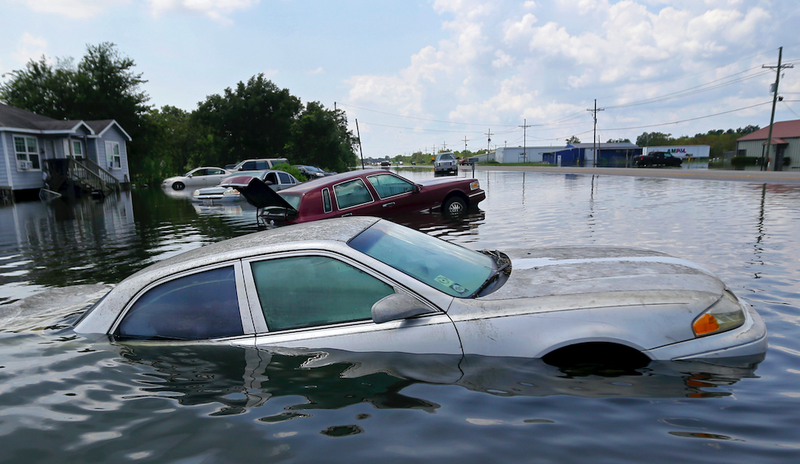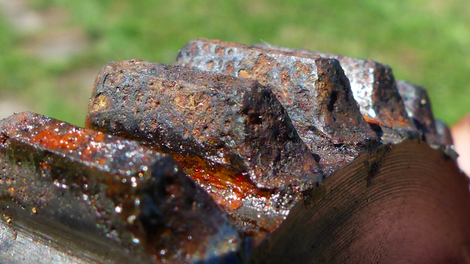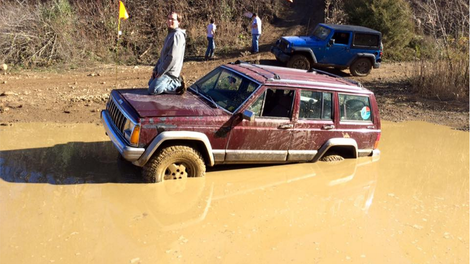
Hundreds of thousands of cars along the Texas Gulf Coast could be totaled after Hurricane Harvey dumped trillions of gallons of rain on the region. If your car got caught out in the flood—or any flood—you may think it needs to be replaced immediately. If you’re lucky, there are things you can do to save it.
A reader named Chris recently emailed me to ask what his grandpa should do with his Ford Victoria, which was flooded by Hurricane Harvey. Chris wrote:
My grandfather recently finished rebuilding a ‘56 Ford [Victoria] from a field find to a beautiful show car. Unfortunately he was in the aftermath of hurricane Harvey and is hoping for an insurance claim from haggerty for his car after the storm and is unsure what the insurance company will give him.
He continued:
My dad wants to take over the salvage value of the car and I want to make sure he’s working on all the right things as he rebuilds he car. The car was essentially submerged in about five and a half feet of water so it will definitely need the engine rebuilt and flushed out as well as the interior gutted and redone.
Here’s a look at the car before the storm:
Here’s how it sits now:
Many vehicles—especially new ones with complex electrical systems—may not be worth trying to save if they’ve been completely submerged in water. But with vehicles like Chris’s Grandpa’s (a fairly old car)—and even the one in the top photo whose engine bay and dash are out of the water—maybe, just maybe, there’s still hope.
Engine
I’ve been taking my Jeeps through deep mud and water for many, many years now. And while it causes complications sometimes, for the most part, a foot or two isn’t the end of the world.
OK, I should qualify that statement: a foot or two of water can indeed be the end of the world if your engine sucks water into its cylinders like mine did a few years ago.
Advertisement
On that fateful day, I drove my Jeep Cherokee through a deep water puddle, which was enough to completely submerge my intake. As I gave my Jeep the beans, the pistons tried sucking in air, but could only pull in water, which they couldn’t compress. Here’s the result:
But just because my Jeep snapped its connecting rods doesn’t mean your engine is necessarily toast just because it cut out under water. Indeed, if my foot hadn’t been so deep on the throttle, my venerable four-liter would have been turning slowly enough to where those two slugs of water in cylinders one and six would just have stalled out the engine instead of bending its rods. As long as I hadn’t tried cranking the engine over at that point, my engine would likely have been savable.
As for how I’d have saved my Jeep, there’s a fairly straightforward method that off-roaders have used for years. Simply remove the spark plugs, crank the starter over, and watch those pistons shoot H20 from the plug holes (you may also want to pour some ATF into the cylinders to get them nice and lubed). From there, you’ll want to dump the water out of the air box, replace the drenched air filter, and drain the oil (as water will almost certainly have made its way into the crankcase).
Water in the crank case is a big deal, since it tends to displace the oil used to keep your engines bearings from wearing down on their journals. A water-contaminated engine’s connecting rod and main bearings will wear down in short order, ultimately requiring an extensive and expensive rebuild.
Transmission, Differentials, Transfer Case
But engine oil isn’t your only concern when it comes to lubricants. Your car’s transmission, transfer case, and differentials also need to have clean fluids in them, or they’ll be toast before you know it. If you don’t believe me, take a look at what happened to my 1948 Willys Jeep’s gears after being in contact with water-contaminated gear oil:
Gearboxes can let water in a number of ways. In the case of my transmission, that water came in through the top shifter housing. But many gearboxes tend to have rubber vent hoses that allow them to breathe, and those—when submerged in water—can let water in. Here’s how the oil in my water-contaminated differential looked:
And water in the steering box is no good, either:
The point here is that water not only affects oil’s ability to maintain a thin film of lubrication between moving parts, but it also introduces corrosion into the system. Contaminated oil and corrosion are recipes for increased wear rates. Not to mention, water can do a number on clutches, which can be found in manual and automatic transmissions, as well as transfer cases, so it needs to be drained as soon as possible.
Advertisement
The fear of contaminated lubricants goes for not only gearboxes, but also grease-filled CV-axles, ball joints, wheel bearings and tie-rod ends, all of which rely on clean grease to maintain proper lubrication between slidingor rolling parts. Though they’re designed to withstand heavy water splashes, being submerged for a long time could introduce water that could prematurely wear these parts down.
So it’s a good idea to replace all of your vehicle’s oils, and to keep eye on key steering and suspension parts (replacing them entirely might be the wiser call).
Brakes, Cooling System, Fuel System
Your engine cooling system, hydraulic brake system, and fuel system are all meant to be sealed from the elements, so there’s a decent chance they’ll remain unharmed by a flood. But there’s still always that chance that water could get high enough to fill the engine coolant reservoir, fuel tank and brake master cylinder (this is especially an issue for the latter, since brake fluid is hygroscopic).
Contaminated engine coolant can cause your motor to rust or overheat, moisture in brake fluid can cause poor braking performance (particularly under spirited driving conditions), and water in fuel will cause your engine to run poorly (which could theoretically cause engine damage over time).
You’ll want to check these fluid levels. It’s a fairly straightforward job for the master cylinder and coolant reservoir, but the fuel tank may require a syphon. If you remember exactly how much fuel you had before the flood, and that level is about the same afterwards, chances are, your fuel system is OK.
Interior
Most people tend to worry most about a car’s interior. And while it’s true that damp carpeting can mold, and that cleaning an interior can be a bear, the job is far from impossible.
Advertisement
I called up Dale from Paul’s Auto Interior in Pontiac, Michigan, to ask what he’d do about a flooded car, and he said step one is to gut the cabin to the bare floor.
This means removing the carpets, seats, and door panels—essentially everything but the dash and steering wheel. From there, clean the car’s body with soap and water (Dale from Paul’s Auto recommended “Simple Green”), and let it dry.
He then said he’d take the seats apart; that means not just taking them out of the car, but actually removing the foam from the seat covers, power washing all of the parts with antibacterial soap (some dish soaps will work fine) and letting all of it dry in the sun.
Advertisement
The same process applies to the carpet, but Dale specifies that the “jute” padding glued under the carpeting absolutely has to go, as it will never truly dry, and will just lead to mold. Dale says cleaning the carpet with soap and water, letting it dry, replacing the jute, and laying the new rug on a clean floorboard is the best way to keep a car’s interior from molding after a flood.
As for the interior plastics, Dale says using a powerful cleaner that kills mold and mildew (again, antibacterial dish soap will work), drying the parts, and letting them air out before reinstalling can bring a flooded interior back to life.
Electrical
Here’s where it gets complicated. If your car has been flooded to its roof, and it’s a modern car filled with dozens of computers, you may be shit out of luck.
Advertisement
Though NAPA Auto Parts recommends disconnecting as many connectors as you can, and blowing them out with a hairdryer, that may not be enough (it’s worth noting that WD-40 is fairly decent at displacing water from electrical connectors). As anyone who’s dropped their cell phone into a water puddle knows, wet computer parts almost always result in hard-to-track electrical gremlins. On older cars, this isn’t such a huge issue, since there are only three wires in the whole car—all of which can easily be replaced.
But on newer vehicles, which have electrical connectors all over, including right along the floorboards (to activate the seat-mounted side air bags), flood damage can become a major issue. Not only can the insides of the connectors corrode, but the wiring harnesses can, too (though sometimes it may not happen immediately).
Low-mounted wiring like starter motors, ABS sensors and tire pressure monitoring sensors can be replaced fairly easily. But if a modern car’s engine’s computer, and especially the dashboard takes a dip into Davey Jones’ Locker, figuring out why your rear driver’s side window keeps going up and down might drive you into madness.
Advertisement
In many cases, whether it’s worth trying to save your car comes down to how much of your electrical system saw water, and how many wire harnesses and control modules you’re willing to replace.
There’s A Lot To Think About
The video above by YouTuber JBMediaWerks gives you a good starting point for assessing the damage to a car that’s been flooded. As it points out, between ensuring there’s no water in your cylinders, keeping fluids decontaminated, cleaning your interior, and praying that not too many sensors and wires made it below the water line, there’s a lot to think about when trying to bring a car back from flood damage. And that’s not even accounting for potential corrosion issues that could result from water introducing dirt into hard-to-clean parts of the body.
Advertisement
Whatever happens, you likely have a hell of a job ahead of you. Whether your car is something new or older and with a bunch of emotional attachments, think long and hard on whether it’s something you want to keep after a flood.
















